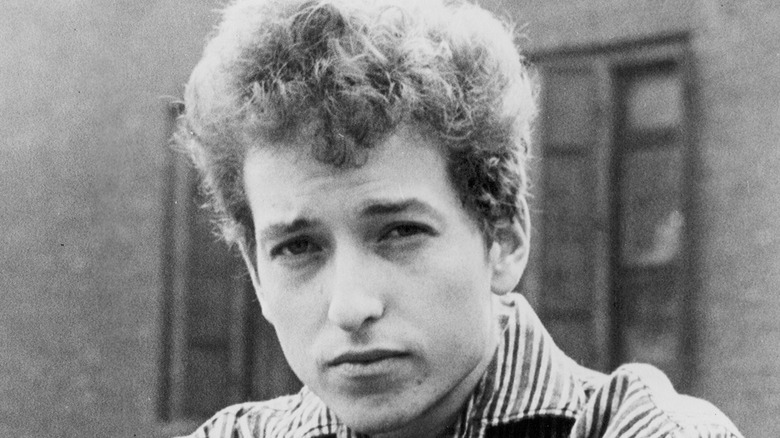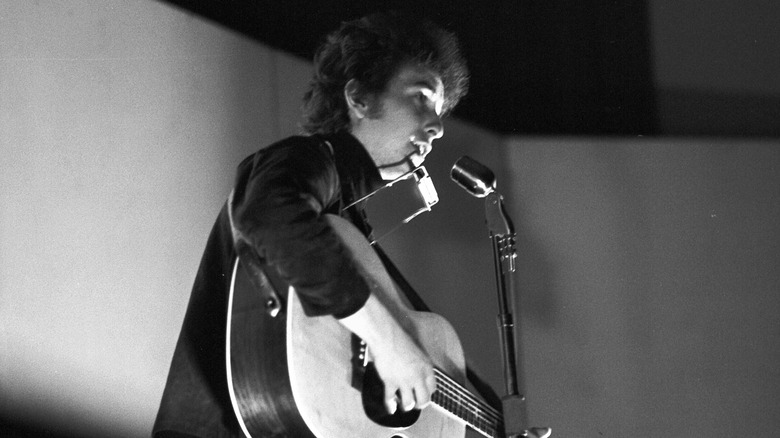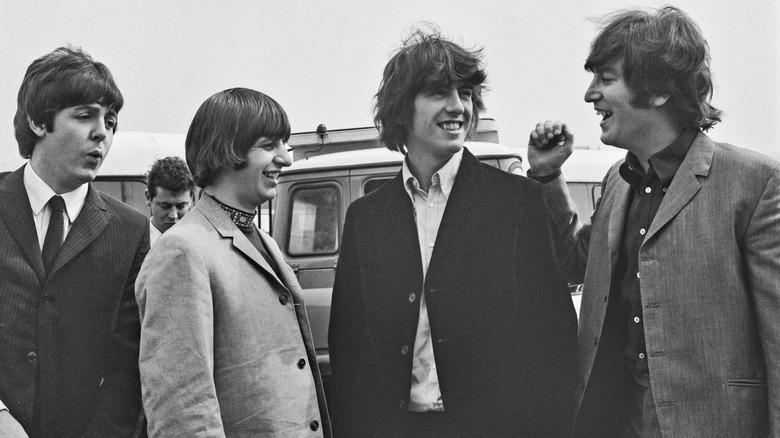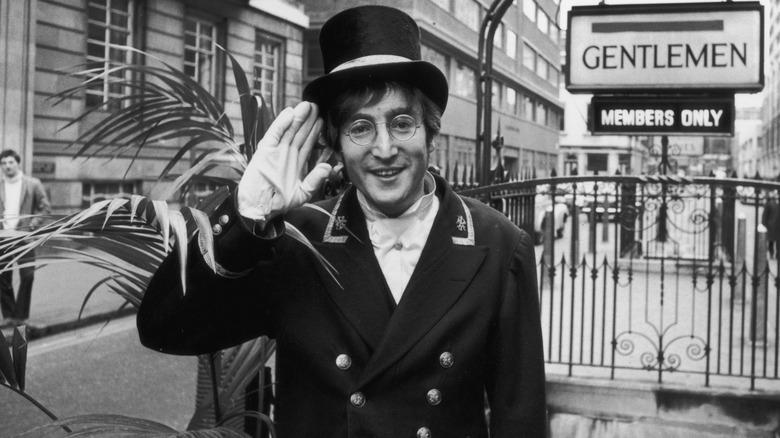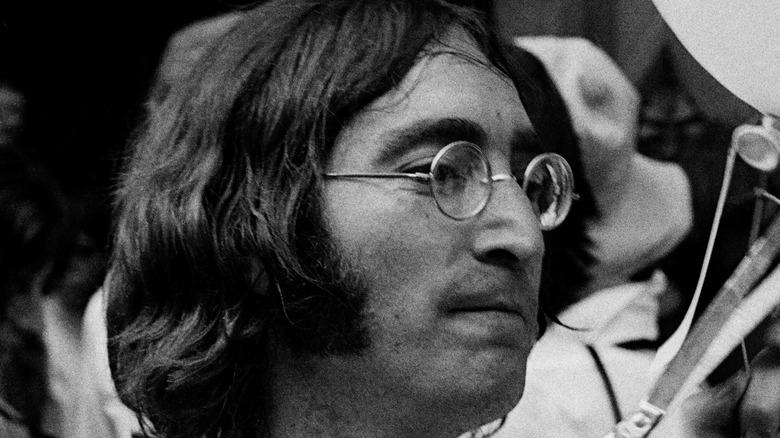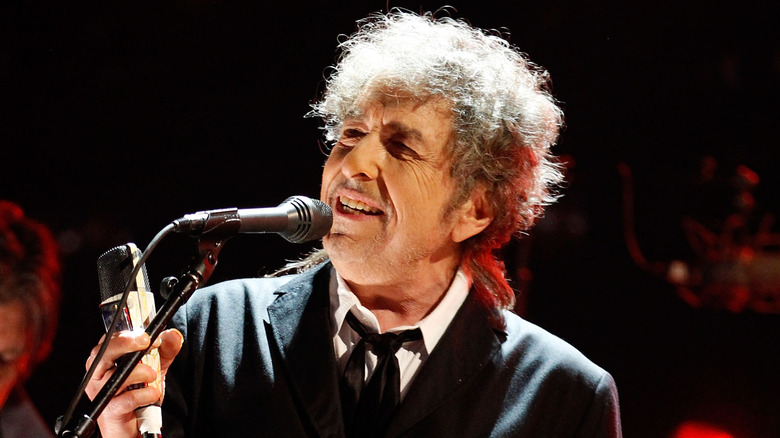The Complicated Relationship Between Bob Dylan And John Lennon
During their early years, the Beatles, then a struggling act from Liverpool playing gigs in Hamburg for little money and even less recognition back home, drew inspiration from a wide range of artists. Buddy Holly and the Crickets were among those key influences, and that even extended to the band's name — if these guys from Texas called themselves the Crickets, these young English lads were going to name themselves after another insect ... and slightly change the spelling. Other American acts, such as Chuck Berry and the Everly Brothers, were also highly influential, and all those groups and singers mentioned above continued informing the Beatles' sound as they rose from hometown heroes to the biggest rock band in the world.
Around the same time that the Beatles were enjoying international superstardom, there was another musician from the U.S. whose sound and lyrical flair were slowly creeping into the Fab Four's recordings. Robert Allen Zimmerman, better known to the world at large as Bob Dylan, was developing a growing following through his early albums, and the Beatles took notice, with one member, in particular, holding a great amount of respect and admiration for the singer-songwriter. That Beatle was John Lennon, and he and Dylan had quite the interesting — and complex — relationship. Here's what we know about Dylan and Lennon's relationship and how it progressed through the years.
Dylan introduced Lennon and the Beatles to weed
Although the Beatles initially became Bob Dylan fans in the spring of 1964, the band's first documented encounter with the singer took place on August 28 of that year when the Beatles, then staying at a New York hotel, were introduced to the American musician by writer Al Aronowitz, a mutual friend. According to the Beatles Bible, the Fab Four didn't have any of the cheap wine that Dylan preferred to drink, and when they offered him some purple hearts (a popular stimulant at the time), the folk troubadour and Aronowitz declined, suggesting instead that they smoke marijuana. After the Beatles claimed to have never smoked pot, John Lennon and Dylan had a bit of an awkward moment, with the latter expressing surprise due to how the band supposedly had a song about "getting high." That tune was actually the innocuous love song "I Want to Hold Your Hand," and Dylan had allegedly misheard the words "I can't hide" as "I get high."
Years later, Lennon would admit that he barely remembered anything about that first meeting with Dylan. "I don't remember much what we talked about," he said. "We were smoking dope, drinking wine and generally being rock 'n' rollers and having a laugh, you know, and surrealism. It was party time." The other Beatles, on the other hand, had more vivid memories of the moment, but beyond this apparent introduction to the green stuff, August 28, 1964, marked the beginning of Dylan's relationship with Lennon as a fellow musical heavyweight.
The Beatles' 1965 album Rubber Soul was heavily influenced by Dylan
"Rubber Soul" is often mentioned as a turning point for the Beatles as songwriters. Previously a singles-oriented band, the Beatles would become more of an album band. And as far as songwriting goes, "Rubber Soul" was the album where the Fab Four arguably did the most to apply what they learned from Bob Dylan's music. Sure, there were slightly earlier songs such as "I'm a Loser" from "Beatles for Sale" — John Lennon called that track an example of "me in my Dylan period." Then you've also got "You've Got to Hide Your Love Away" from the "Help!" album. But following those one-off efforts, many of the songs from the Beatles' second 1965 album, "Rubber Soul," were influenced by the folk-rock hybrid that Dylan was becoming famous for.
As pointed out by The Atlantic, Dylan's influence on Lennon was not at all surprising despite the fact they came up in different environments — the former musician in the quiet coffeehouses of New York, the latter in the chaotic Hamburg club scene with the rest of the Beatles' pre-Ringo Starr lineup. As such, Lennon was most likely "challenged and inspired" by the maturity of Dylan's songs in comparison to the simple, two-and-a-half-minute (or thereabouts) pop tunes the Beatles were so good at crafting.
Going back to the Dylan influence in "Rubber Soul," one song in particular, "Norwegian Wood," seems to stand out more so than the others. But imitation wasn't the highest form of flattery in this case, as Dylan apparently didn't take kindly to the Beatles recording a song in his style.
Dylan allegedly wasn't pleased that Lennon was seemingly copying his style
Instead of being impressed that four musicians from England had tipped their hats to him on their most recent album, Bob Dylan was supposedly bothered by how much his music had influenced the Beatles' "Rubber Soul." Per Far Out Magazine, the pioneering folk-rocker didn't seem to understand why several acts — not just the Beatles — were dipping their toes into his distinctive style of music. "What is this? It's me, Bob. [John Lennon's] doing me! Even Sonny & Cher are doing me, but, f***ing hell, I invented it," he was quoted as saying.
On his next album, 1966's "Blonde on Blonde," Dylan appeared to battle back with the song "4th Time Around," which was essentially a stylistic parody of "Norwegian Wood," an imitation of a perceived imitation. Speaking to Rolling Stone's Jonathan Cott in 1968, Lennon recalled that he wasn't a fan of this parody, and that hearing it made him feel unnerved. "I was very paranoid about that," he said. "I remember he played it to me when he was in London. He said, what do you think? I said, I don't like it. I didn't like it. I was very paranoid. I just didn't like what I felt I was feeling –- I thought it was an out and out skit, you know, but it wasn't. It was great. I mean he wasn't playing any tricks on me. I was just going through the bit."
Lennon name-checked Dylan and one of his lyrics on the White Album
According to The Atlantic, things seemed tense between John Lennon and Bob Dylan in May 1966 when the latter was in England for his first electric tour of the country. While the two would-be legends did share a limousine ride together, there was a bit of awkwardness between them, which Lennon would chalk up to his own personal jitters ... and the illicit substances he and Dylan were consuming. "I just remember we were both in shades and both on f***ing junk ... I was nervous as s***," he recalled. "I was on his territory, that's why I was so nervous."
Despite the aforementioned "Norwegian Wood" parody and that infamous limo ride, Lennon's Dylan worship continued, and that was on display in "Yer Blues," a track off the Beatles' self-titled 1968 release — the "White Album," as it's most popularly known. The song expressed Lennon's inner torment at the time while also being a stylistic parody (that term again) of the blues, and while the lyrics are known for being among the darkest in Beatles history, they do contain a nod to Dylan in the form of the lyric "feel so suicidal, just like Dylan's Mr. Jones," with Mr. Jones being the lead character in the singer's "Ballad of a Thin Man."
If you or anyone you know is having suicidal thoughts, please call the National Suicide Prevention Lifeline at 1-800-273-TALK (8255).
Dylan paid tribute to Lennon in one of his more recent songs
As it appeared, Bob Dylan and John Lennon's relationship was one-sided, with Lennon seeing Dylan as one of his biggest heroes and Dylan seeing Lennon as a pesky fan who copied his style on many a song. And while many Beatles songs were influenced by Dylan, the American singer-songwriter didn't really draw inspiration from Lennon's work, "4th Time Around" notwithstanding. But the song "Roll On John," from Dylan's 2012 album "Tempest," told a different story. The lyrics clearly reference key moments in Lennon's career, from his beginnings with the Quarrymen to the lyrics of the Beatles' "A Day in the Life" to his tragic murder in 1980.
As opined by The Atlantic, surface-level analysis of "Roll on John" suggests that Dylan and Lennon's friendship was far more traditional than it actually was. However, when closely studied and when taking into account the fact that the two men didn't interact that often during their heyday in the 1960s, the tune doesn't talk about Lennon as Dylan knew him back in the day. Instead, it was described as a typical Dylan song that focuses on the myth and the historical significance of its subject, similar in fashion to songs like "Hurricane," which was written about wrongfully convicted boxer Rubin "Hurricane" Carter.
